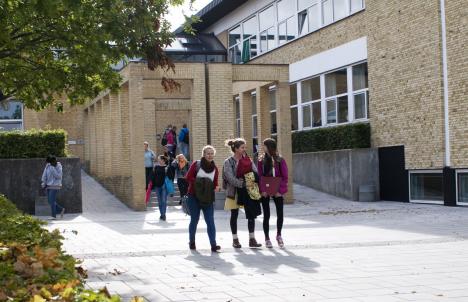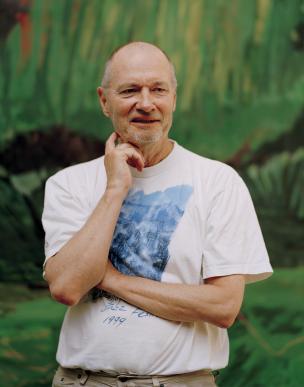
WHEN ART MIMICS A PLACE
“The door to Louisiana.” “DSB (Danish State Railways) advertises for Louisiana.” “Art on the train platform.” “Louisiana station.” These headlines filled the local newspapers when Per Kirkeby’s brick sculpture at Humlebæk Station was inaugurated in 1994. Louisiana Museum had come over to the station, and the trip became part of the museum experience.
Landmark for Louisiana
Kirkeby’s brick sculpture at Humlebæk Station was conceived deliberately as a landmark for the museum: a sort of introduction to a trip to the museum that heralds the experience you are undertaking. The sculpture was erected in collaboration with DSB (the Danish Railways). It belongs to Humlebæk Station and was intended for the site. From its form and material, it is apparent that it is intended to be experienced in the context of the surrounding architecture. If you arrive on the coast line, you have come past several similar station buildings. The red bricks and arches in particular are recurring features. In this way, the sculpture seems to position itself between what you are coming from on the train ride – that is, the architecture – and what you are heading towards – art and the museum.
Between function and form
At first sight, the Kirkeby sculpture at Humlebæk Station appears to be a building – it resembles the small building beside it, only it is simpler. That it is not a building becomes apparent for anyone who goes through it or tries to take shelter inside. There is neither roof nor walls that can provide shelter from rain and wind, so the large form remains a pure form. Rather than being a building, Kirkeby’s work seems rather to be a reference to a building: something everyone knows and recognizes. But without the function that we associate with a building.
Kirkeby’s brick sculptures seem to have another effect. They seem rather to be breaks and passages in the surroundings. Sometimes they repeat form elements and materials from the environment, as at Humlebæk Station. Other sculptures are placed on landscapes where the bricks tend to function more clearly as alien elements. Yet another type blends in so much in the urban space that it almost disappears as an independent structure. What the sculptures share is that they are intended to be spatial ornaments or patterns more than rooms or spaces in themselves.
At Vesthimmerland Gymnasium, Kirkeby has designed the entrance. Here the structure has a function: It connects the buildings and serves as passage between outside and inside, but it is also clearly an independent structure that is not part of the buildings. There are no roof and walls here either, but a sense of space is still created in the passage.
“The wall is of course a large ornament.” Per Kirkeby, 1995
While it stands out slightly in relation to its surroundings by resembling a room without enclosing it completely, it leans up against the rest of the building with its yellow bricks.
FILM
FACTS
Per Kirkeby (b. 1938) has worked with painting, graphics, film, poetry and sculpture since the 1960s. Originally, he studied geology (1957-64) but afterward he switched to art, which still shows traces of his interest in geology. In the 1960s, he was part of the Ex School (the Experimental Art School) in Copenhagen. The Ex School was established by the artist Poul Gernes in 1961 as an alternative to the Royal Danish Academy of Fine Arts. It was a protest against old traditions and emphasized cooperation between teacher and student as well as process rather than finished work.
Kirkeby’s art is very diverse: His paintings are richly colored and contain many traces of stories even though they are mainly abstract. His bronze sculptures can be huge (like the Tor sculpture in Louisiana Park) or small and originally formed from a single piece of clay, while his brick sculptures have more simplicity and a larger scale. The brick sculptures are reminiscent of the minimalist artistic movement because of their repetitions, the very simple shapes, and the use of industrially manufactured material (bricks) as well as the viewer’s opportunity for a bodily experience of the work. Like his paintings, however, they also contain traces of stories, partly through their material and their relation to the surroundings, from which they often borrow formal elements.
Kirkeby’s monumental brick sculptures are found in many places in Europe. In Denmark, they can be found on Læsø and in Nakskov, Aalborg, Års, Vemb and several locations in and around Copenhagen. The first, Huset (The House), in Ikast, was built in 1973.
Per Kirkeby is well represented with both sculptures and paintings in Louisiana’s collection.
ACTIVITIES
Most people choose to walk around Kirkeby’s brick sculpture at Humlebæk Station rather than through it. What do you do? If you walk around it, what would make you go through it? What would make you stay in the sculpture?
The idea behind the position of Per Kirkeby’s sculpture was to establish an “art path” between Humlebæk Station and Louisiana. The sculpture highlights Humlebæk as a special station on the Coast Line and also doubles as a preview of a museum visit at Louisiana. It is some distance from the station to the museum, however. Make a proposal for a second brick sculpture to be placed on the art path to Louisiana. Where should it be located? Explain why. What should it look like? What elements in the environment should be repeated in it, as the arches in the station building are in Kirkeby’s sculpture at Humlebæk Station?
On the Web, find images of several of Kirkeby’s brick sculptures and consider which of them interact in harmony with the sites where they are located and which stand in contrast to the sites.
Kirkeby’s sculptures occupy a position between sculpture and architecture. Although they are located in a variety of places, they are all built in brick. They thus relate to a Danish and northern European building tradition. Likewise, wooden houses, for example, remind one of a Swedish tradition. Find materials and/or construction traditions that make you think of a specific place. (Location-specific materials can also be things you find in a place and thus are associated with a special use of a place.)
Interdisciplinary work, with design: Make a model of a sculpture that uses shapes and/or materials from architecture. Take a picture of it and cut it out. Then place it in various types of setting to see how the material relates to a forest, for example, or water, an Asian metropolis or a French lavender field.
Tip for students: For this assignment, you can use your own photos or search the Web for a country, ocean, metropolis, jungle or other setting, or for names of countries or cities, where you want to place your model.












